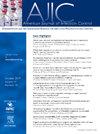Indicator-based tuberculosis infection control assessments with knowledge, attitudes, and practices evaluations among health facilities in China, 2017 to 2019
IF 3.8
3区 医学
Q2 INFECTIOUS DISEASES
引用次数: 0
Abstract
Background
Tuberculosis Building and Strengthening Infection Control Strategies (TB BASICS) aimed to achieve improvements in TB infection prevention and control (IPC) through structured training and mentorship.
Methods
TB BASICS was implemented in 6 Chinese provinces from 2017 to 2019. Standardized, facility-based risk assessments tailored to inpatient, laboratory, and outpatient departments were conducted quarterly for 18 months. Knowledge, attitudes, and practices surveys were administered to health care workers (HCW) at 9 participating facilities during the first and last assessments. Kruskal-Wallis rank sum test assessed score differences between departments (alpha = 0.05).
Results
Fifty-seven departments received risk assessments. IPC policies and practices improved substantially during follow up. Facility-based assessment scores were significantly lower in outpatient departments than other departments (P < .05). All indicators achieved at least partial implementation by the final assessment. Low scores persisted for implementing isolation protocols, while personal protective equipment use among staff was consistent among all departments. Overall, we observed minimal change in IPC knowledge among HCW. In general, HCW had favorable views of their own IPC capabilities, but reported limited agency to improve institutional IPC.
Conclusions
TB BASICS demonstrated improvements in TB IPC implementation. Structured training and mentorship engaged HCW to maintain confidence and competency for TB prevention.
2017-2019年中国卫生机构基于指标的结核病感染控制评估及知识、态度和实践评估
背景:结核病(TB)建立和加强感染控制战略(TB BASICS)旨在通过有组织的培训和指导改善结核病感染预防和控制(IPC)。方法:2017-2019年在中国6个省份实施TB BASICS。针对住院部、化验室和门诊部进行了标准化的、基于设施的风险评估,每季度进行一次,持续18个月。在第一次和最后一次评估期间,对九个参与机构的卫生保健工作者(HCW)进行了知识、态度和实践调查。Kruskal-Wallis秩和检验评估科室间得分差异(alpha = 0.05)。结果:57个科室接受了风险评估。IPC政策和做法在跟踪期间得到了实质性改进。门诊基于设施的评估得分明显低于其他部门(p结论:TB BASICS表明结核病IPC的实施有所改善。有组织的培训和指导使卫生工作者保持对结核病预防的信心和能力。
本文章由计算机程序翻译,如有差异,请以英文原文为准。
求助全文
约1分钟内获得全文
求助全文
来源期刊
CiteScore
7.40
自引率
4.10%
发文量
479
审稿时长
24 days
期刊介绍:
AJIC covers key topics and issues in infection control and epidemiology. Infection control professionals, including physicians, nurses, and epidemiologists, rely on AJIC for peer-reviewed articles covering clinical topics as well as original research. As the official publication of the Association for Professionals in Infection Control and Epidemiology (APIC)

 求助内容:
求助内容: 应助结果提醒方式:
应助结果提醒方式:


